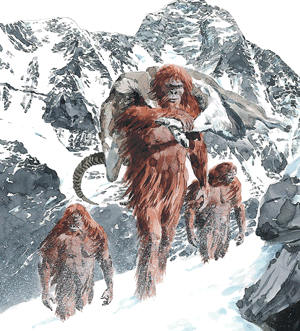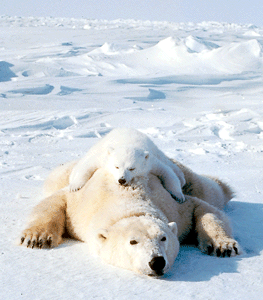Not Yeti, Maybe Someday
Thursday, July 3rd, 2014July 3, 2014
Recent findings are sure to disappoint people who believe that the Yeti, or Abominable Snowman, stalks the Himalaya and that Bigfoot prowls the Pacific Northwest in the United States. In a study published last week, British scientists who examined samples of “Yeti hair” sent in by museums and cryptozoologists (people who study and search for legendary creatures) reported finding no Yeti yet. The study appeared online in the Proceedings of the Royal Society B.

The Yeti is a creature said to live on Mount Everest and other mountain ranges of Asia. According to legend, the Yeti is a hairy beast with a large, apelike body and a face that resembles that of a human being. (World Book illustration by Ted Lewis).
Many people are fascinated by the idea that a large primate like the Yeti—or its American cousin, Bigfoot, or Russian relative, Almasty—could survive in remote wilderness areas unexplored by modern science. Cryptozoologists have investigated the Yeti for decades. Sensational reports of Yeti sightings have been exposed as hoaxes and fakes in the past, which has led many skeptics to dismiss the creature as pure fantasy.
The study on Yeti hair was led by Bryan Sykes, a geneticist at Oxford University. In 2012, Sykes requested samples of hair from Yeti enthusiasts, saying, “I’m challenging and inviting the cryptozoologists to come up with the evidence instead of complaining that science is rejecting what they have to say.” Scientists on the study ended up analyzing the DNA of more than 30 of the 57 “Yeti hair” samples submitted. The remaining samples were eliminating after the scientists found that they were not hair but such substances as fiberglass. The researchers discovered that most of the 30 analyzed hair samples came from such common animals as cows, horses, raccoons, deer, and coyotes. None of the samples came from a new primate species.
Two of the samples, however, were less straightforward: one was found in Ladakh—a region in Jammu and Kashmir, the northernmost state in India; and the other came from Bhutan to the east. The tests revealed that the hair was from a mammal, but it did not match samples from known primates. Surprisingly, the DNA from the two samples matched up almost exactly with DNA from the 40,000-year-old jawbone of a Norwegian polar bear. The researchers do not believe that the “Himalayan Yeti” actually represents an isolated population of polar bears. Instead, they theorize that the region is home to a hybrid bear species unknown to science that developed from matings between polar bears and brown bears somewhere in northern Asia during the last Ice Age, when the ranges of those bears overlapped.
Sykes admits that the study does not disprove the existence of the Yeti or other large primates unknown to scientists; it only means that the samples submitted for analysis did not come from such creatures. Enthusiasts need to keep looking for evidence that stands up to scientific scrutiny.
Additional World Book articles:



